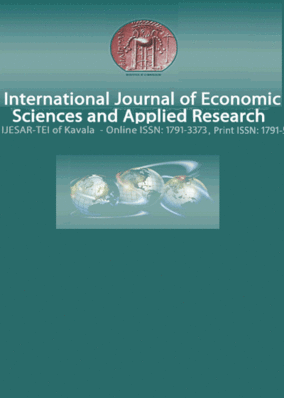Business cycle correlation between the Euro area and the Balkan countries
Part of : International journal of economic sciences and applied research ; Vol.7, No.1, 2014, pages 33-49
Issue:
Pages:
33-49
Author:
Abstract:
This paper examines the degree of trade integration and business cycle synchronization between eight Balkan countries and the Euro area over the period 2000:1-2011:4. The main findings are that Slovenia and the Former Yugoslav Republic of Macedonia exhibit a high level of openness relative to Euro area and seem to have achieved a large degree of business cycle synchronisation with the aggregate Euro area cycle. The other Balkan countries are characterized by high trade integration with the EMU (except Greece and Turkey) and a rather modest degree of association with the Euro area cycle, although Turkey is nearest the average of the EMU countries. We further document that there is a tendency for an increase in the degree of synchronisation with EMUfor all Balkan countries. We also note, however, that at the end of the period, the degree of synchronisation has become less pronounced.
Subject:
Subject (LC):
Keywords:
business cycles, synchronization, Balkan countries, European integration, Euro area
Notes:
Περιέχει εικόνες και βιβλιογραφία, JEL Classification: E32, F15, F41
References (1):
- Afonso, A. and Furceri, D., 2008, ‘EMU enlargement, stabilization costs and insurancemechanisms’, Journal of International Money and Finance, 27, 2, pp. 169-187.Akkoyun, H., Günay, M. and $en-Dogan, B., 2012, ‘Business Cycle Synchronization ofTurkey with Euro Area and the US: What Has Changed After 2001?’ Central Bank ofthe Republic of Turkey Working Paper , 12/15, Turkey.Artis, M. and Zhang, W., 1997, ‘International Business Cycles and the ERM: Is there aEuropean Business Cycle?’, International Journal of Finance and Economics, 2, 1, pp.1-16.Artis, M. and Zhang, W., 1999, ‘Further evidence on the international business cycle andthe ERM: Is there a European business cycle’, Oxford Economic Papers, 51, 1, pp. 120-132.Babetskii, I., 2005, ‘Trade integration and synchronization of shocks - Implications for EUenlargement’, Economics of Transition, 13, 1, pp. 105-138.Baxter, M. and King, R., 1999, ‘Measuring Business Cycles: Approximate Band-PassFilters for Economic Time Series’, Review of Economics and Statistics, 81, pp. 575-93.Bayoumi, T. and Eichengreen B., 1993, ‘Shocking Aspects of European MonetaryUnification’, Torres F. and Giavazzi, F., Adjustment and Growth in the EuropeanMonetary Union, Cambridge University Press, pp. 193-229.Bayoumi, T. and Eichengreen, B., 1997, ‘Ever closer to heaven? An optimum-currency-area index for European countries’, European Economic Review, 41,3-5, pp. 761-770.Bayoumi, T., 1994, ‘A formal model of optimum currency areas’, IMF Staff Papers, 41,4,pp. 537-554.Bencik, M., 2011, ‘Business cycle synchronisation between the V4 countries and the euroarea’,National Bank of Slovakia Working and Discussion Papers, 1, Slovakia.Botric, V., 2013, ‘Determinants of Intra-industry Trade between Western Balkans and EU-15:Evidence from Bilateral Data ’, International Journal of Economic Sciences andAppliedResearch, 6, 2, pp. 7-23.Damyanov, A. and Stefanov, G., 2010, ‘Business Cycle Synchronizations between theBulgarian Economy and the European Union’, South-Eastern Europe Journal ofEconomics, 8, 2, pp. 171-185.Darvas, Z. and Szapâry, G, 2008, ‘Business cycle synchronization in the enlarged EU’Open Economies Review, 19, 1, pp. 1-19.De Grauwe, P. and Mongelli, F., 2005, ‘Endogeneities of Optimum Currency Areas: WhatBrings Countries Sharing a Single Currency Closer Together? ’, European Central BankWorking Paper Series, 468.Dumitru, I. and Dumitru, I., 2010, ‘Business cycle correlation of the new member stateswith Eurozone - the case of Romania’, Romanian Journal of Economic Forecasting , 13,4, pp. 16-31.Fidrmuc, J., 2004, ‘The Endogeneity of the Optimum Currency Area Criteria, Intra-IndustryTrade, and EMU Enlargement’, Contemporary Economic Policy, 22, pp. 1-12.Fidrmuc, J. and Korhonen, I., 2006, ‘Meta-analysis of the business cycle correlationbetween the euro area and the CEECs’, Journal of Comparative Economics, 34, 3, pp.518-537.Frankel J., 1999, ‘No Single Currency Regime is Right for all countries or at all times’,Essays in International Finance, 215, Princeton University.Frankel, J. and Rose, A., 1998, ‘The Endogeneity of the Optimum Currency Area Criteria’Economic Journal, 108, pp. 1009-1025.Gligorov, V, Iara, A., Landesmann, M., Stehrer, R. and Vidovic, H., 2008, Western BalkanCountries: Adjustment Capacity to External Shocks, with a Focus on Labour Markets,The Vienne Institute for International Economic Studies Research Reports, 352, Austria.Gomez, D., Ortega, G. and Torgier, B., 2012, ‘Synchronization and diversity in businesscycles: A network approach applied to the European Union’, Center for Research inEconomics, Management and the Arts {CREMA) Working Paper Series, 1, CREMA,Switzerland.Harding, D. and Pagan, A., 2002, ‘Dissecting the cycle: a methodological investigation.’Journal of Monetary Economics, 49, pp. 365-81.Hodrick, R. and Prescott, E., 1997, ‘Postwar U.S. Business Cycles: An EmpiricalInvestigation’, Journal of Money Credit and Banking, 29, pp. 1-16.International Monetary Fund (IMF), 2010, World Economic Outlook October 2010,International Monetary Fund Publication Services, Washington.International Monetary Fund (IMF), 2012, Annual Report on exchange arrangementsand exchange restrictions 2012, International Monetary Fund Publication Services,Washington.Kenen, R, 1969, ‘The Theory of Optimum Currency Areas: An Eclectic View’, Mundell,R.and Swoboda, A., Monetary Problems of the International Economy, University ofChicago Press, Chicago, pp. 41-60.Krugman, P. 1993, ‘Lessons from Massachusetts for EMU’, Torres, F. and Giavazzi,F.,Adjustment and Growth in the European Union, Cambridge University Press,Cambridge, pp. 241-60.McKinnon, R., 1963, Optimum Currency Areas’, The American Economic Review, 53, 4,pp. 717-25.Mongelli, F., 2005, ‘What is European Economic and Monetary Union Telling us Aboutthe Properties of Optimum Currency Areas?’ Journal of Common Market Studies, 43,3, pp. 607-35.Mundell, R., 1961, ‘A Theory of Optimum Currency Areas’, The American EconomicReview, 51,4, pp. 657-65.Savva, C., Neanidis, C. and Osborn, D., 2010, ‘Business cycle synchronization of the euroarea with the new and negotiating member countries’, International Journal of Finance&Economics. 15, 3, pp. 288-306.Sideris, D., 2010, ‘The Western Balkans on the road to the EU: An assessment of theirintegration with the euro zone using the Generalized Purchasing Power Parity approach’,Bank of Greece.The Economist Intelligence Unit, 2012, ‘Eastern Europe economy: Balkan vulnerability’,June 14 th.Tsanana, E., Katrakilidis, C. and Pantelidis, P., 2012, ‘Balkan Area and EU-15: An EmpiricalInvestigation of Income Convergence’, Karasavvoglou, A. and Polychronidou, R,Balkan and Eastern European Countries in the Midst of the Global Economic Crisis,Contributions to Economics, Springer-Verlag Berlin Heidelberg.Vesselinov, R., 2012, ‘New Composite Indicators for Bulgarian Business Cycle’,International Journal of Economic Sciences and Applied Research, 5, 2, pp. 101-111.




